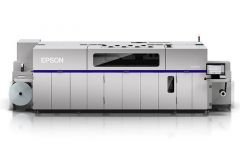Faced for some with the disappearance of markets, particularly in the continuous mode, the dematerialization of certain media or the decline in print runs, family commercial printers have to imagine their future, which involves inevitable market developments.
Web to Print
The sale of printed products to professionals (B to B) or individuals (B to C), through dedicated sites or portals, powered by technologies such as PrintFlux can be an important growth driver for printers, by widening their catchment area and enabling them to address new markets in order to saturate their industrial facilities. However, this approach requires a service-oriented sales strategy in B-to-B, supported by a sales force duly trained to do so, or a real marketing strategy for a consumer site, the prerequisite of which is a substantial marketing budget, because the time is long past when one could launch a successful site with 3 francs six sous...
The large format
The market for visual communication and branding are trades related to commercial printing that have strong growth potential. Although they require equipment whose investment is low compared to commercial investments, it is based on a simple premise: learning to handle many "small" markets, or on the contrary, knowing how to take on markets including calls for delivery, in sectors such as events. The development of posing services may be essential to deal with certain clients such as distribution. As a corollary to visual communication, a new trend is appearing in this sector, which concerns the combination of large-format posters with video screens, connected via the Internet, which will eventually make printers who go down this path become true advertising agencies. ( read our article )
The adhesive label
A market long reserved for specialists, due to complex technologies (flexo and finishing), the self-adhesive label market is opening up to commercial printers, thanks to the development of digital rotary presses (inkjet or toner), coupled with finishing lines and in particular in-line laser cutting. These technologies, which are relatively accessible, make it possible to process short and medium runs of labels, which are markets that are growing very rapidly. Eventually, certain purely flexo markets will evolve towards digital, due to the productivity of certain digital presses (Durst). The advantage of these new types of presses is that they do not require personnel very different from those already in place in a traditional commercial printer.
Industrial printing
In this field, the aim is to take a real step forward by printing industrial media such as RFID labels, antennas of all types, oled lighting, biomedical sensors, solar cells, printed circuits, etc. In short, to manage the industrial printing part of a production line at a final customer's site. This is still a rare development in the commercial world, but one for which the printer has real technical skills, while having to learn how to manage a relocated workshop, the prerequisite of which is the implementation of a precise commercial strategy. In this respect, it is interesting to note that the French manufacturer MGI has just acquired the French leader in printed electronics, a move that will undoubtedly lead to a whole range of suitable machines ...



















